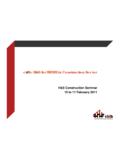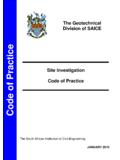Transcription of NATIONAL ACTION PLAN FOR THE CONSERVATION OF …
1 NATIONAL ACTION plan . FOR THE CONSERVATION OF CHEETAH. AND. african WILD DOG IN ETHIOPIA. March 2012. Ethiopian Wildlife CONSERVATION Authority NATIONAL ACTION plan FOR THE CONSERVATION OF. CHEETAH AND african WILD DOG IN ETHIOPIA. Copyright: Ethiopia Wildlife CONSERVATION Authority (EWCA). Citation: EWCA, 2012, NATIONAL ACTION plan for the CONSERVATION of Cheetahs and african Wild Dogs in Ethiopia, Addis Ababa, Ethiopia Reproduction of this publication for educational, CONSERVATION and other non-commercial purposes is authorized without prior written permission from the copyright holder provided the source is fully acknowledged Reproduction of this publication for sale or other commercial purposes is prohibited without prior written permission of the copyright holder Preface It is with great satisfaction that I hereby endorse the Cheetah and Wild Dog CONSERVATION ACTION plan on behalf of the Ethiopian Wildlife CONSERVATION Authority.
2 The recommendations and policy directions described in this plan will be guiding our work for the coming five years, because we believe that they represent best practice and will promote persistence of the cheetah and wild dog in Ethiopia. The cheetah and wild dog are emblematic species for Ethiopia. Our wildlife assemblage would not be complete without them; indeed our biodiversity would not be complete without these flagship species. Of course this comes at a cost: we must mitigate conflict with farmers and maintain wild landscapes with sufficient prey base. We acknowledge the assistance of NATIONAL and international partners in organising the workshop that created consensus on the issues and in drafting the Cheetah and Wild Dog CONSERVATION ACTION plan . We count on the collaboration of those partners, and other stakeholders, in the implementation of this plan . Signed in Addis Ababa, 12 March 2012.
3 Dr. Kifle Argaw Director General Ethiopian Wildlife CONSERVATION Authority NATIONAL ACTION plan FOR THE CONSERVATION OF. CHEETAH AND african WILD DOG IN ETHIOPIA. Contents 1. SUMMARY . 4. 2. INTRODUCTION..5. Background.. 5. Planning large carnivore CONSERVATION in Ethiopia .5. NATIONAL planning within a rangewide context ..5. Biology and CONSERVATION needs of african wild dogs..6. Biology and CONSERVATION needs of cheetahs 9. The eastern african regional workshop 10. The Ethiopia NATIONAL workshop .11. Structure of this report ..11. 3. DISTRIBUTION AND STATUS OF CHEETAHS IN ETHIOPIA .. 12. Historical distribution 12. Current distribution ..12. Conclusions .15. 4. DISTRIBUTION AND STATUS OF WILD DOGS IN ETHIOPIA 16. Historical distribution 16. Current distribution .16. Conclusions .. 19. 5. THREATS TO CHEETAHS AND WILD DOGS IN ETHIOPIA .20. Introduction .. 20. Proximate threats ..20. Constraints on alleviating threats.
4 21. Conclusions .21. 6. STRATEGIC plan FOR CHEETAH AND WILD DOG CONSERVATION IN ETHIOPIA 22. Background .22. Structure of the strategic plan .22. 7. IMPLEMENTATION OF THE NATIONAL ACTION plan .25. REFERENCES ..26. APPENDIX 1. List of participants .30. APPENDIX 2. Agenda of the NATIONAL workshop 31. APPENDIX 3. NATIONAL strategic plan logical framework 34. APPENDIX 4. Abbreviations used in this report ..43. APPENDIX 5. Acknowledgements ..44. CHAPTER 1 . SUMMARY. The african wild dog (Lycaon pictus) and the cheetah (Acinonyx jubatus) present major challenges for conservationists in the 21st Century. All large carnivores need large areas to survive; yet wild dogs and cheetahs range more widely, and hence need larger areas, than almost any other terrestrial carnivore species anywhere in the world. As human populations encroach on Africa's last wild areas, these two globally threatened species are often the first to disappear.
5 Ethiopia supports populations of both cheetahs and wild dogs, but the challenge to their CONSERVATION remains lack of knowledge about their numbers and distribution. The urgent need for this ACTION plan is underscored by the high human population density ( NATIONAL average approx. 71 people per sq. Km) in Ethiopia and consequent loss of wildlife habitat to agriculture and other human activities. There is rapid expansion of land under agriculture and construction in Ethiopia, so connectivity between cheetah and wild dog habitats in Ethiopia needs to be considered by the authorities planning these developments. The CONSERVATION of these species is being planned together because of the wide overlap in their CONSERVATION needs, particularly in the area of spatial ecology. This NATIONAL ACTION plan for their CONSERVATION is the first step in a programme to manage and conserve Ethiopia's large carnivore species, with other plans for the other species to follow.
6 A number of Ethiopia's important wild dog and cheetah populations straddle international boundaries, particularly the borders with Kenya and southern Sudan. Transboundary management in collaboration with Kenya and South Sudan will therefore be required for long term CONSERVATION of both species in Ethiopia. The Ethiopian Wildlife CONSERVATION Authority (EWCA) is the appropriate authority to oversee the implementation of this ACTION plan , in partnership with a number of NGOs. 4. CHAPTER 2 . INTRODUCTION. Background The african wild dog (Lycaon pictus) and the cheetah (Acinonyx jubatus) present major challenges for conservationists in the 21st Century. Both species were formerly widely distributed in Africa, but both have experienced dramatic reductions in numbers and geographic range in recent decades (Ray, Hunter &Zigouris, 2005). All large carnivores need large areas to survive; yet wild dogs and cheetahs range more widely, and hence need larger areas, than almost any other terrestrial carnivore species anywhere in the world.
7 As human populations encroach on Africa's last wild savannas, wild dogs and cheetahs . particularly susceptible to the destruction and fragmentation of habitat are often the first species to disappear. Despite their globally threatened status (wild dogs are listed as endangered and cheetahs as vulnerable (IUCN, 2006a)), their ecological importance as top carnivores (Woodroffe & Ginsberg, 2005b), and their value to Africa's tourism industry (Lindsey et al., 2007), to date remarkably little CONSERVATION ACTION has been implemented for these two species. The majority of Africa's protected areas are too small to conserve viable populations, and active CONSERVATION efforts on unprotected lands have hitherto been restricted to a handful of projects. Three factors have hindered CONSERVATION activity for cheetahs and wild dogs: (1) The species' massive area requirements mean that CONSERVATION planning is needed on a daunting spatial scale, rarely seen before in terrestrial CONSERVATION .
8 (2) Information is lacking on the species' distribution and status, and on the tools most likely to achieve effective CONSERVATION . (3) Capacity to conserve these species is lacking in most african countries; expertise in managing more high-profile species such as elephants and rhinos may not be transferable to wild dogs or cheetahs because the threats and CONSERVATION challenges are likely to be different. Against this background, CONSERVATION issues associated with wild dogs and cheetahs are being addressed together because, despite being taxonomically quite different, the two species are ecologically very similar and hence face very similar threats. Planning large carnivore CONSERVATION in Ethiopia The NATIONAL ACTION plan for cheetah and wild dog CONSERVATION in Ethiopia is the first of a suite of strategic plans for the CONSERVATION and management of the country's flagsip species. A CONSERVATION ACTION plan for Lion is currently under development.
9 These strategies are being developed within a common framework and together, are intended to achieve: (i) numerically viable and ecologically functional populations of all large carnivore species native to Ethiopia;. (ii) numerically viable and ecologically functional populations of key wild prey species within Ethiopia;. and (iii) a reduction of human-carnivore conflict in Ethiopia, and (iv) a reduction of illegal capture and smuggling of live animals across Ethiopia's international boundaries NATIONAL planning within a rangewide context This NATIONAL ACTION plan for the CONSERVATION of cheetahs and wild dogs in Ethiopia was developed as part of a Rangewide CONSERVATION Planning Process for these two species. Recognising the serious CONSERVATION issues facing cheetahs and wild dogs, in 2006 the Cat and Canid Specialist Groups of the IUCN/SSC, in partnership with the Wildlife CONSERVATION Society (WCS) and the Zoological Society 5.
10 Of London (ZSL) initiated a process to plan for the species' CONSERVATION across their combined geographic range. This process, conducted in close partnership with government CONSERVATION authorities, aims to develop a coordinated array of NATIONAL CONSERVATION ACTION plans for all range states, nested within broader regional strategies. The Rangewide CONSERVATION Planning Process has six stated objectives: (1) To foster appreciation for the need to conserve wild dogs and cheetahs, particularly among CONSERVATION practitioners in range states. (2) To collate information on wild dog and cheetah distribution and abundance on an ongoing basis, in order to direct CONSERVATION efforts and to evaluate the success or failure of these efforts in future years. (3) To identify key sites for the CONSERVATION of wild dogs and cheetahs, including corridors connecting important CONSERVATION areas. (4) To prepare specific global, regional and NATIONAL CONSERVATION ACTION plans for both cheetahs and wild dogs.






